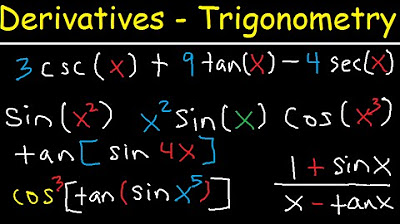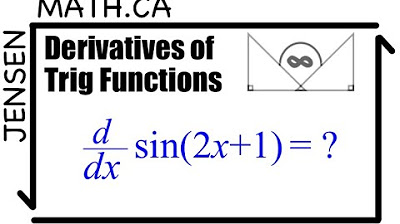Chain Rule Day 2
TLDRThis educational video script presents a detailed exploration of the chain rule in calculus, focusing on finding second derivatives and simplifying expressions. The instructor demonstrates the process step-by-step, including the use of the product and quotient rules, and employs a graphing calculator to verify results. The script also discusses finding horizontal tangents by setting derivatives to zero and uses graphs to determine derivatives from visual data. The session concludes with examples of composite functions and their derivatives, emphasizing the importance of correctly applying the chain rule.
Takeaways
- 📚 The video discusses the application of the chain rule in calculus, emphasizing the importance of simplification after finding derivatives.
- 🔍 The presenter demonstrates finding the second derivative of a function, showcasing the process of differentiating and then differentiating the result again.
- 📈 The first derivative of the given function is simplified by factoring out common terms and multiplying through by constants.
- 📉 The second derivative is found using both the product rule and the chain rule, highlighting the need to differentiate each part of the function separately.
- 🔢 The presenter simplifies the expression for the second derivative, showing the process of combining like terms and factoring out common factors.
- 📝 The video mentions the use of a TI-89 calculator to verify the results of derivatives, indicating the utility of technology in mathematical problem-solving.
- 📌 The concept of horizontal tangents is introduced, explaining that they occur where the derivative of a function equals zero.
- 🤔 The process of finding horizontal tangents involves setting the derivative equal to zero and solving for the variable, as demonstrated with an example.
- 📊 The video includes a graph to visually confirm the existence of a horizontal tangent at a specific point, emphasizing the value of graphical analysis.
- 📐 The quotient rule is briefly mentioned for finding derivatives of quotients, with a note on the importance of correctly applying the rule.
- 📈 The presenter explores the derivative of a composite function, explaining that the derivative of the outside function is taken while keeping the inside function intact.
- 📘 The video concludes with examples of finding derivatives from graphs, illustrating the application of derivative concepts in a visual context.
Q & A
What is the main topic discussed in the video script?
-The main topic discussed in the video script is the application of the chain rule in calculus, specifically in finding derivatives of functions, including second derivatives and horizontal tangents.
What is the first example given in the script about finding the derivative of a function?
-The first example given is finding the first derivative of a function, which involves simplifying the expression 12 times x squared minus 5 squared, and then multiplying it by 2x.
How does the script simplify the expression for the first derivative?
-The script simplifies the expression by factoring out the 2x, resulting in 24x times x squared minus 5 squared.
What is the second derivative of the function discussed in the script?
-The second derivative is found by differentiating the first derivative again, which requires the use of the product rule and the chain rule.
How does the script approach finding the second derivative using the product rule?
-The script treats 24x as the first function and x squared minus 5 squared as the second function, then applies the product rule by multiplying the derivative of the first function by the second function and vice versa.
What is the significance of simplifying the derivative expression in the script?
-Simplifying the derivative expression helps in understanding the function's behavior more clearly and can make it easier to find specific points of interest, such as horizontal tangents.
What does the script mention about the TI-89 calculator and its use in finding derivatives?
-The script mentions that the TI-89 calculator can be used to find derivatives and verify the results obtained manually, ensuring accuracy.
What is a horizontal tangent in the context of the script?
-A horizontal tangent refers to a point on the graph of a function where the slope of the tangent line is zero, which corresponds to where the derivative of the function is equal to zero.
How does the script find the points where the function has a horizontal tangent?
-The script finds the points with horizontal tangents by setting the first derivative equal to zero and solving for the variable x.
What is the quotient rule mentioned in the script, and how is it used?
-The quotient rule is a method used to find the derivative of a quotient of two functions. It is used in the script to find the derivative of a function that is a quotient, by multiplying the derivative of the denominator by the numerator and subtracting the product of the derivative of the numerator and the denominator, all divided by the square of the denominator.
How does the script handle the calculation of derivatives from a graph?
-The script uses the given graphs of functions F and G to find the derivative at specific points by identifying the slopes and y-values at those points.
What is the chain rule mentioned in the script, and how is it applied?
-The chain rule is a method used to find the derivative of a composite function. In the script, it is applied by taking the derivative of the outer function and multiplying it by the derivative of the inner function.
Outlines
📚 Calculating Derivatives and Simplifying
This paragraph discusses the process of finding the second derivative of a given function. The first derivative is calculated using basic differentiation rules, resulting in an expression involving \(24x(x^2 - 5^2)\). The second derivative is then found by applying the product rule and the chain rule, leading to a more complex expression. The speaker emphasizes the importance of simplifying the derivative, which they do by factoring out common terms. The process is demonstrated using both manual calculations and a TI-89 calculator, showing that the simplified form of the second derivative is \(4(x^2 - 5)^3\). The paragraph also touches on finding points where the function has a horizontal tangent, which occurs when the derivative is zero.
🔍 Analyzing Horizontal Tangents and Derivatives from Graphs
In this paragraph, the focus shifts to finding horizontal tangents and derivatives from graphs. The speaker explains how to determine horizontal tangents by setting the derivative equal to zero and solving for the variable. They demonstrate this with an example involving a quotient function, simplifying the derivative and finding the point where the derivative is zero, which is \(x = 1\). The resulting point is \((1, 1)\). The speaker also discusses how to find derivatives from graphs, using the product and quotient rules to calculate \(H'(1)\) and \(K'(6)\) from given functions F and G. The process involves identifying the slopes and values from the graphs and applying the rules accordingly.
📉 Derivative Calculations Involving Composite and Quotient Functions
The final paragraph delves into derivative calculations for composite and quotient functions. The speaker explains how to find the derivative of a function that is the product of two other functions, using the product rule. They also discuss the derivative of a quotient function, illustrating the quotient rule with an example. The speaker then moves on to calculating derivatives from graphs, showing how to find \(P'(6)\) and \(T'(7)\) by using the chain rule and identifying slopes and function values from the graphs. The paragraph concludes with a demonstration of how to find the derivative at a specific point by multiplying the derivative of the outer function by the derivative of the inner function.
Mindmap
Keywords
💡Chain Rule
💡Derivative
💡Product Rule
💡Quotient Rule
💡Second Derivative
💡Horizontal Tangent
💡Composite Function
💡Graph
💡Slope
💡TI-89
Highlights
Introduction to chain rule examples and the importance of simplifying answers.
Explanation of finding the second derivative by first finding the derivative and then the derivative of the derivative.
Demonstration of simplifying the first derivative of a function involving x squared and constants.
Use of the product rule and chain rule to find the second derivative.
Simplification of the second derivative expression.
Verification of the derivative using a calculator and the importance of matching the calculator's output.
Finding points where a function has a horizontal tangent by setting the derivative equal to zero.
Use of the quotient rule to find the derivative of a quotient function.
Explanation of how to find horizontal tangents by setting the numerator of a derivative equal to zero.
Graphing a function to visually confirm the presence of a horizontal tangent.
Using a calculator to confirm the slope at a specific point to verify a horizontal tangent.
Finding the derivative of a composite function using the chain rule.
Using graphs to find derivatives and slopes at specific points.
Explanation of the product rule in the context of finding derivatives from graphs.
Finding the derivative of a quotient function using the quotient rule from a graph.
Using the chain rule to find the derivative of a composite function from a graph.
Calculating the derivative at a specific point using the chain rule and graphing.
Transcripts
Browse More Related Video

Calculus AB Homework 3.4 The Chain Rule

AP Calculus AB and BC Unit 3 Review [Differentiation: Composite, Implicit, and Inverse Functions]

Calculus - The product rule for derivatives

Derivatives of Trigonometric Functions - Product Rule Quotient & Chain Rule - Calculus Tutorial

Derivatives of Trig Functions - Calculus | MCV4U

Calculus 1 Lecture 2.3: The Product and Quotient Rules for Derivatives of Functions
5.0 / 5 (0 votes)
Thanks for rating: